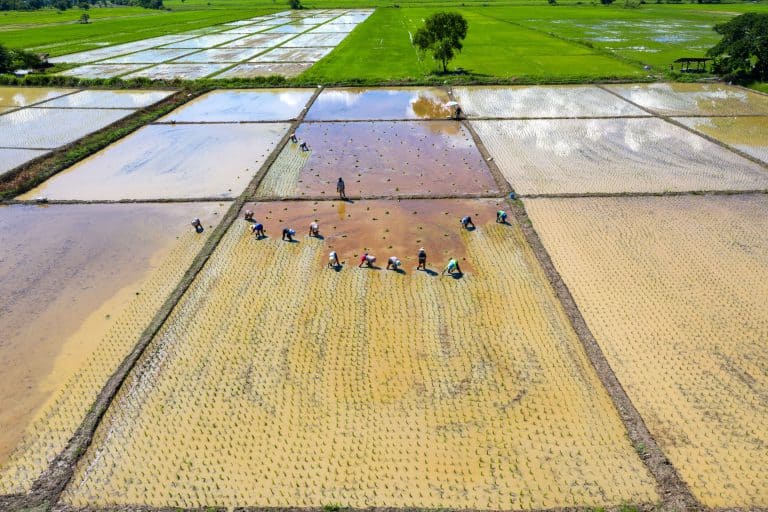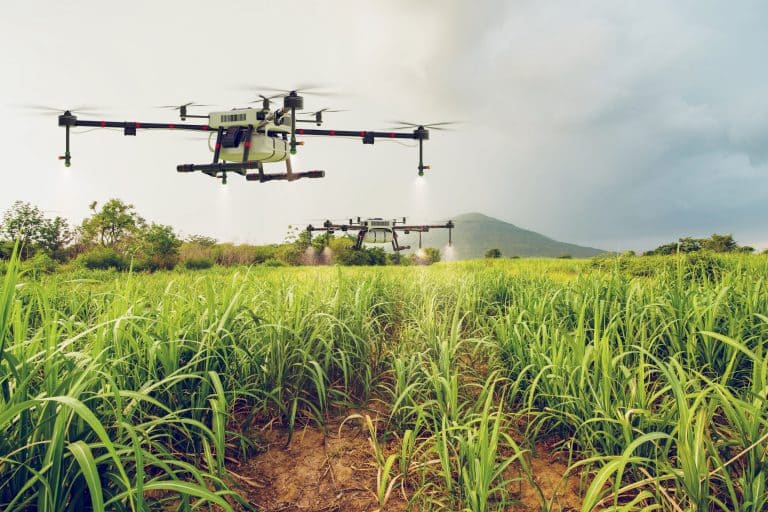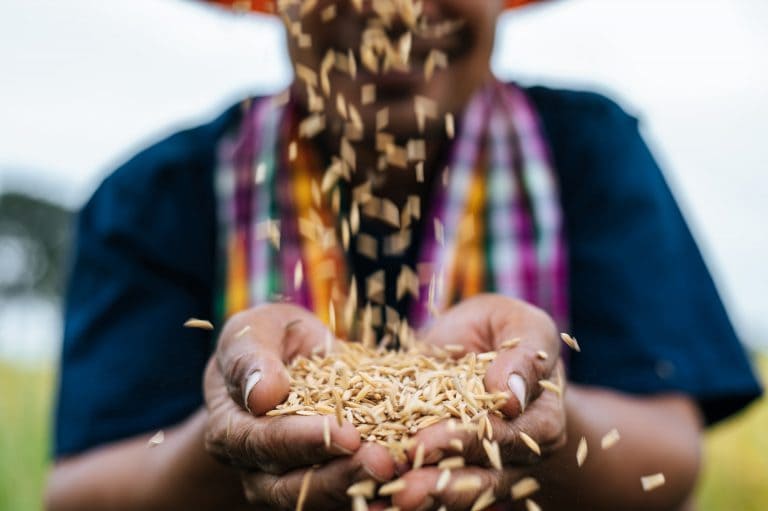Thailand is undoubtedly entering a truly elderly society as medical advancements improve the health of ageing people. The increasing number of older adults is also a significant social and economic force because they still can pursue jobs in numerous industries, including the operations of the Thai agricultural sector. According to the National Statistical Office of Thailand, the majority of the elderly employed in Thailand (60.8%) were skilled agricultural and fishing workers, followed by service workers and vendors. The elderly, adept at agriculture and fisheries, outnumber others in almost every region, with the Northeast having the largest number at 78.6%, followed by the South and the North.1
One study suggests that approaching a truly ageing society will harm the agricultural sector of Thailand. Productivity significantly will decrease if the share of older workers in agricultural production increases (compared to working-age workers).2 In addition, another study conducted in the Mae Taeng District in Chiang Mai Province illustrates the difficulty of elderly farmers. Despite the government’s Thailand 4.0 initiative, most farmers there were elderly and lacked communication technology capabilities. Their quality of agricultural products is substandard. Most farmers lack the resources necessary for organic agriculture. Monitoring agencies for agricultural promotion fail to gain continued financing.3

Many countries experience the same challenge of an ageing society in the agricultural sector as Thailand. But these countries have developed a distinctive approach to assisting elderly farmers through the use of communication technologies. Japan’s technological design, which intelligently responds to an ageing farming community, is an intriguing example of the use of technology to improve the lives of elderly farmers. Researchers and developers created a ‘four-part information system’ based on information technology to manufacture and distribute leaves and flowers for food decoration (tsumamono) at Irodori Company in Kamikatsu.4 The information system of Irodori is composed of four elements:
(1) Collecting and transmitting real-time product information from the wholesale market through communication technology.
(2) Forecasting the demand by analysing past market trends with the computer programme.
(3) Sending order information, market trends, and demand forecast to all farmers in real-time.
(4) Publishing information to the market with online collaboration.
The company is also developing an interface and barcode system to verify the product manufacturer easier.
Irodori’s leaf and flower decoration business is an example of an organisation that successfully integrates the lives of the elderly with the use of agricultural resources in rural areas and the business development process. Irodori has embraced information technology in various ways. The first is to reduce the distance between regions by linking them to the metropolitan consumer market with online systems, such as establishing a two-way system. With online technology, the company collects data from numerous markets across the country and transmits delivery information from the production area to the market through a local network. The second target is to overcome the disadvantages of living in a mountain community with a low population density because it is difficult to build a connectivity infrastructure. The third vision is to assist the elderly to overcome their problems and negative attitudes regarding the use of personal computers and the Internet. The company’s success is not based only on the creation of interface systems but also on easy access to vital information, such as market sales statistics and the ranking of urban farmers by sales volume.
Many stakeholders in Thailand have looked for ways to boost agricultural outputs through the use of communication technology in an effort to find a solution to the problem of an ageing population in the agricultural sector. The Puey Ungphakorn Institute of Economic Research, for example, has attempted to design a mechanism to increase production efficiency in an ageing society by disseminating agricultural technology and innovation that accounts for variations in spatial household structure and agricultural activities.5 Most households with older workers are multigenerational ones. This is an advantage because it combines the experience and wisdom of elderly workers with the ability to learn, adapt, and decide to accept technology. The Institute has proposals for agricultural policies in the ageing society, namely: (1) increasing technology to replace the elderly to increase production efficiency; (2) trying to attract more young workers to the agricultural sector with financial incentives and various assistance programs, as well as the transfer of knowledge, technology, and innovation to young workers; (3) supporting older workers to leave the agricultural sector; and (4) creating measures to help and build immunity for agricultural households with elderly farmers.

Obviously, the online world has become a source of income and education for farmers, particularly older farmers. The Agricultural Research Development Agency revealed that online activities and inventions inspired by the online world could improve older farmers’ lives in various ways.6
(1) Promoting innovative knowledge. Hence, elderly farmers could study and strive to establish the framework for employing this knowledge for their own benefit.
(2) Contributing to agricultural decision-making by improving knowledge of unfamiliar issues, primarily scientific facts. Individuals may adopt a newly identified online method to make potentially high amounts of production.
(3) Generating more income than ever due to agricultural products’ accessibility. This is owing to the potential of the online world to create trends and build excitement by, for example, generating an engaging story in the farmland, facilitating direct sales from the manufacturer to the consumer, and alerting outsiders to agricultural problems via online media.
In addition, there is an increasing awareness of agricultural digital technology development. According to another published study from the Puey Ungphakorn Institute for Economic Research, there are numerous mobile applications for agriculture in Thailand. Still, they provide limited functions and have few customers.7 Most focus on delivering agriculture-specific services, education, and information. Even with fewer applications, agricultural apps can be of considerable use to senior farmers in several ways.
In terms of production, mobile apps can be used to enhance agriculture productivity, forecasting with models, smart farming, and highly accurate forecasts of the environmental situation, as well as check on the soil condition or even sharing resources through online platforms. Smallholder farmers who lack equipment may also request to rent it from other farms. In terms of marketing, they can assist in developing an online trading platform by gathering and disseminating market data through crowdsourcing and collecting information for product standards. This will enable farmers to access marketplaces and sell their produce at higher prices. Regarding finances, technology can facilitate elderly farmers’ access to funding sources such as online fundraising from many individuals through online networks, direct loans between farmers, etc.
In addition, the Institute noted that among Thai farmers, particularly the elderly, there are still significant problems with communication technology; (1) awareness of agricultural technology; (2) understanding of the problem of one’s own repetitive behaviours, which are frequently associated with traditional farming methods; and (3) the rapid ageing of the Thai agricultural sector, for which many sectors are unprepared. Therefore, in order to resolve the issues above, the Institute suggests the development of high-quality farming technology. The government should have the following policy directives: (1) encouraging access to infrastructure for small companies; (2) enhancing access to the consumer base of small-scale farms by creating networks with farmer groups; and (3) stimulating competition among themselves so that quality is continuously improved.

Furthermore, the Bank of Thailand (BOT) stated that elderly farmers continue to have restrictions on embracing technology and innovation because their attitudes and beliefs about traditional farming have not changed, as well as a lack of funds to invest in machinery and the use of technology. According to BOT, if collaborating to expand the Thai agriculture industry and assisting farmers in turning to technology and innovation in the digital economy, we can improve the country’s foundations and reduce income inequality by applying the following principles.8
(1) ‘Forwarding’ information and traditional wisdom among the farmers, hence fostering community transparency.
(2) ‘Adding’ knowledge of new technologies and breakthroughs from government agencies and academic institutions with the combination of theory and practice.
(3) ‘Adjusting’ attitudes and values or altering the perception that agriculture is a profession with close economic and cultural ties to nature. Therefore, they can be free to develop their own alternative agricultural strategies.
The elderly farmers may improve their behaviour and change their views following the recommendations mentioned above, including those from diverse stakeholders, such as community policymakers and private investors in agriculture. As in Japan, applying communication technologies in developing production systems, transportation, and sales will assist elderly farmers in obstacle avoidance and achieving results. Ultimately, if we are able to apply the ideas of the research mentioned above, the development of agricultural products will aid in reaching the future generation’s market, or even a remote market, with the hopes that the quality of life of senior Thai farmers will improve and that they will continue to enjoy their employment.
Editorial team
Published on July 5, 2022
References
- National Statistical Office of Thailand. (2031). Summary of important results of working for the elderly in Thailand, 2021. http://www.nso.go.th/sites/2014/DocLib13/ด้านสังคม/สาขาแรงงาน/Labor_of_the_elderly/2564/pocketbook_64.pdf
- Wirotsattabut, C., Suphannachart, W., & Praneetvatakul, S. (2019). Effect of Aging Society on Labor Productivity in Thai Agriculture. Khon Khaen Agriculture Journal, 47(3), 419-432.
- Meedaycha, N., Kruekum, P., Sakkatat, P., & Kanokhong, K. (2019). Perception of Agricultural Development under Thailand’s 4.0 Policy of Farmers in Sobperng Sub-district, Maetaeng District, Chiang Mai. Journal of Agricultural Research and Extension, 37(3), 60-70.
- Hashimoto, K. (2012). Agri-business for elderly people through the Internet. The example of the Irodori leaf business. Netcom. Networks and Communication Studies, 26(3/4), 235-250. https://doi.org/10.4000/netcom.1012
- Puey Ungphakorn Institute for Economic Research. (2019). How does the ageing situation, the productivity and agriculture of Thai agricultural households affect the development of the agricultural sector? https://www.pier.or.th/abridged/2019/13/
- Agricultural Research Development Agency. (n.d.). Farmers must understand and implement innovations appropriately. https://www.arda.or.th/knowledge_detail.php?id=47
- Puey Ungphakorn Institute for Economic Research. (2019). Digital technology and the improvement of the quality of life of Thai farmers. https://www.pier.or.th/abridged/2019/19/
- Chanthaphong, S. & Thepkham, P. (2018). Agricultural innovations: A solution to Thailand’s inequality Problem Part 2. https://www.bot.or.th/Thai/ResearchAndPublications/DocLib_/Article_24Apr2018.pdf
